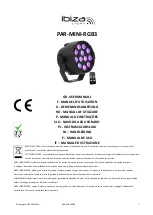4-25
The Algorithms and their Parameters
"Split" Setup
Algorithms
General Description
Dual Delays
The Dual Delay algorithm consists of 2 types of delay lines: Gliding Flange
delays and Fixed delays. This is a true stereo algorithm. (If run in a Dual Mono
Setup, however, it will be mono.)
Two independent flange base delays are available, each with a 20ms range in
single sample steps. There is also a ganged stereo gliding flange delay. There
are two flange gain controls which vary the overall amount of flange effect.
The stereo gliding flange delay is typically modulated by the internal LFO. Setting
the flange gains very high will cause an “over the top” type of flange to occur as
the flange glide delays cross over the base delay pointers. The outputs of the
flange delays are fed to the delay left and delay right lines which are 2.5 seconds
long. Once into these delay lines, you can create many different delay effects.
There are two programmable taps on each delay line. DL1 (left) and DL2 (right)
can be programmed anywhere along this 2.5 second path. There will, however,
be no apparant delay unless a feedback value is assigned to the delay values
via FB1 and FB2. All Pass filters, or diffusors, in line with the feedback paths are
labeled APD1 (All Pass Delay) and APD2. The amount of diffusion is set by AP1
and AP2. When AP is turned high and FB1 is adjusted away from the 0% value,
each feedback loop will be rediffused.
DL3 and DL4 are cross feedback delay lines. They are also adjustable anywhere
along the 2.5 second delay line. DL3 feeds from the left delay position to the input
of the right delay line. The same is true with DL4 feeding into the left delay line.
The feedback parameters adjust the amount (level) passed into the destination
delay lines.
The last pair of delay pointers (LDL and RDL) can be thought of as independently
adjustable post delays. These can be adjusted anywhere along the 2.5 second
delay line.
The output of each delay line can be positioned anywhere in the stereo pan field.
LPAN adjusts the position of the left delay loop; RPAN positions the output of the
right delay loop.
Note: The intensity of the OVER THE TOP and ENVELOPE presets can be
increased by sending the effect a "prefade" signal from your console.
Summary of Contents for M300L
Page 1: ...Digital Effects LARC Interface Owner s Manual 300L...
Page 8: ...1 1 Installing the 300L 1 Installing the 300L...
Page 22: ...2 1 System Overview 2 System Overview...
Page 30: ...3 1 System Operation 3 System Operation...
Page 63: ...Lexicon 300L Owner s Manual 3 34...
Page 64: ...4 1 The Algorithms and their Parameters 4 The Algorithms and their Parameters...
Page 101: ...Lexicon 300L Owner s Manual 4 38...
Page 102: ...5 1 The Presets 5 The Presets...
Page 131: ...5 30 Lexicon 300L Owner s Manual...
Page 132: ...6 1 Time Code Operation 6 Time Code Operation...
Page 142: ...7 1 MIDI Operation 7 MIDI Operation...
Page 152: ...8 1 Troubleshooting 8 Troubleshooting...


















